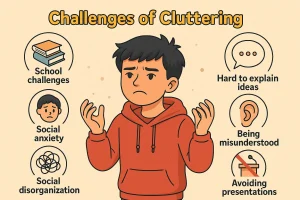7 Engaging Sensory Activities for Adults with Autism
By Wellness Hub
Last Updated: September 27, 2024
Living with autism often means navigating the world through a unique sensory lens. Imagine being in a place where lights, sounds, textures, or even smells can feel amplified. For many adults with autism, sensory processing plays a huge role in how they interact with their surroundings. It’s not just about “sensitivity”; it’s about how the brain makes sense of all the sensory input coming from the outside world.
Sensory activities for adults with autism can be a valuable tool for managing sensory sensitivities and improving overall well-being. Some adults with autism actively seek out sensory experiences—they might enjoy feeling different textures, moving constantly, or even listening to repetitive sounds. Others may find certain sensory stimuli overwhelming and try to avoid them. For example, bright lights, loud noises, or strong smells might make them feel uneasy or anxious. These sensory-seeking and sensory-avoidant behaviors are common among adults on the spectrum, making it important to find the right balance to help them feel comfortable and relaxed.
Also read: Online Behavioral Therapy for Kids with Autism
1. Yoga: A Calming and Structured Sensory Activity
Yoga is more than just a physical exercise—it’s a sensory experience that can be highly beneficial for adults with autism. The practice of yoga provides proprioceptive input, which means it helps improve the sense of body awareness and balance. Imagine being more in tune with where your body is in space and feeling grounded and stable; that’s what yoga offers.
Each pose in yoga, whether it’s a gentle stretch or a more structured movement, helps to calm the nervous system and promote relaxation. It’s like giving your body and mind a gentle “reset.” For adults with autism, this calming effect is particularly helpful in reducing anxiety and stress, creating a sense of peace and control over one’s environment. Even simple poses like “child’s pose” or “mountain pose” can provide comfort and help with focus and body awareness.
Tips for Practicing Yoga as a Sensory-Friendly Activity:
- Start with simple breathing exercises to create a calm environment.
- Try sensory-friendly poses that emphasize grounding, like sitting or lying down on a mat.
- Explore slow, gentle movements to enhance proprioceptive awareness.
Also read: Yoga for Better Speech: 12 Exercises to Help with Stuttering
2. Massage Therapy: Deep Pressure for Sensory Regulation
For adults with autism, feeling connected and in control of their own body can sometimes be challenging. That’s where massage therapy comes in—a gentle yet powerful way to introduce deep tactile input to the body. It’s more than just a relaxing experience; it’s a sensory activity that can have a grounding and soothing effect on the nervous system.
Massage therapy works by applying deep pressure, which is known to calm the nervous system and help regulate sensory input. Think of it like a comforting hug that helps reduce stress and anxiety, promoting a state of calm and relaxation. Deep pressure input, such as that provided during a massage, can also improve body awareness. This makes it easier for individuals with autism to understand their physical space, which can enhance balance, focus, and a sense of well-being.
Benefits of Massage for Sensory Regulation:
- Reducing Stress & Anxiety: A massage session can bring down heightened stress levels, giving a sense of relaxation and comfort.
- Promoting Body Awareness: It helps in recognizing where your body is in space, enhancing proprioception and coordination.
- Creating a Calming Sensory Experience: Deep pressure and tactile input from a massage can act as sensory stimulation that is both enjoyable and therapeutic.
3. Aromatherapy: Harnessing the Power of Scents
Have you ever noticed how certain scents can instantly lift your mood or help you feel more relaxed? That’s the essence of aromatherapy—using different fragrances to influence emotions, stress levels, and sensory responses. For adults with autism, aromatherapy can serve as a calming sensory activity, offering a simple yet powerful way to provide soothing sensory input through the sense of smell.
Certain scents, like lavender, are well known for their calming properties and can help reduce anxiety, promote relaxation, and even improve sleep quality. On the other hand, uplifting scents like citrus can boost energy levels and improve focus. The beauty of aromatherapy is its versatility: you can explore a wide variety of scents based on individual preferences and sensory needs.
Simple Ways to Use Aromatherapy for Sensory Regulation
- Diffusers: Essential oil diffusers are an easy and effective way to fill a space with gentle aromas. A few drops of your favorite calming essential oil, such as lavender or chamomile, can transform a room into a sensory-friendly environment.
- Scented Candles: Candles not only offer soothing scents but also provide a calming visual experience with their soft, flickering light. Opt for natural, non-toxic candles with essential oil fragrances to create a peaceful atmosphere.
- Essential Oils: You can apply essential oils directly to the skin (after diluting them) on pressure points like wrists or temples. This direct contact allows the scent to have a prolonged and gentle sensory effect throughout the day.
- Aromatherapy Bath: Adding a few drops of essential oils to a warm bath can provide a relaxing and immersive sensory experience, perfect for unwinding after a busy day.
Benefits of Aromatherapy for Adults with Autism
- Reduces Anxiety and Promotes Calm: Calming scents like lavender, sandalwood, and vanilla can help reduce feelings of stress and anxiety, offering a gentle way to self-regulate emotions.
- Improves Focus and Sensory Balance: Scents like peppermint or lemon can enhance alertness and concentration, which is especially helpful for adults with autism who may need a sensory boost during specific activities.
- Creates a Personalized Sensory Experience: Since everyone responds to scents differently, aromatherapy is easy to tailor to individual preferences, making it a great way to address unique sensory needs.
Know more about our article on Autism in Adults: Symptoms, Diagnosis, Challenges, and Support
4. Dance Parties: Fun and Movement-Based Sensory Play
When it comes to combining movement and joy, nothing quite matches the energy of a dance party! Dancing offers a dynamic sensory experience that provides vestibular input (related to balance and movement) and auditory stimulation. For adults with autism, dance can be an engaging way to meet sensory needs while having fun. Imagine feeling the beat of the music, moving your body freely, and letting go of stress—all of which make dance parties a great sensory activity for calming.
Why Dance?
Dancing encourages the body to move in different ways, helping to improve coordination, rhythm, and balance. It provides a full-body experience, allowing individuals to express themselves physically while enjoying the music and movement. The rhythmic movements can also help with self-regulation, reducing anxiety and promoting a positive mood.
One of the best aspects of dance is its flexibility—it can be enjoyed solo or as a group activity. Some adults may prefer dancing alone in a comfortable space, letting the music guide their movements. Others might love the social aspect of dancing with family, friends, or in a class setting, which can create opportunities for social interaction and shared experiences. Whether it’s a gentle sway or an all-out dance session, the benefits are numerous.
Sensory Benefits of Dancing
- Vestibular Activities: The movement-based nature of dancing helps improve balance and body control, offering stimulating vestibular input.
- Auditory Stimulation: Dancing to music provides consistent auditory input, which can be both calming and energizing, depending on the choice of music.
- Stress Relief and Self-Expression: Dancing provides an emotional outlet and can serve as a sensory play activity to release pent-up energy or stress.
5. Sensory Bottles: Visual and Tactile Stimulation
Sometimes, the simplest things can have the most profound effects. Sensory bottles are a perfect example—these DIY sensory activities for autism offer both visual and tactile stimulation that can be calming and mesmerizing for adults on the spectrum. Imagine a small, clear bottle filled with colorful beads, glitter, or water, all swirling around to create a soothing experience when shaken. These bottles can help regulate emotions, reduce stress, and offer a fun, hands-on activity that provides a sense of control and calm.
Why Sensory Bottles?
Sensory bottles allow adults with autism to explore different textures, colors, and movements in a controlled way. Watching glitter slowly settle to the bottom or beads float around in a bottle can provide a gentle visual stimulation, helping individuals to relax and focus. Additionally, shaking, tilting, or rolling the bottle offers tactile input that can be grounding and satisfying.
Making Your Own Sensory Bottles
One of the best parts about sensory bottles is how customizable they are. You can easily make them at home with just a few simple materials, making this activity both budget-friendly and creative. Here’s how you can involve the individual in the process:
- Choose the Bottle: Any clear plastic bottle will do. Make sure it’s transparent so you can see the items inside.
- Pick Your Fillers: Think about the sensory experience you want to create. You can use glitter, colored beads, sequins, water, small foam shapes, or even food coloring to change the water’s color. The combination is up to you!
- Add a Liquid Base: You can use water, oil (like baby oil for slower movement), or a mixture of water and glue for thicker fluidity.
- Seal It Tightly: Once the bottle is filled, make sure the lid is tightly sealed to prevent spills. You can use glue around the edges for extra security.
- Explore & Enjoy: Once complete, shake the bottle and watch how the contents move around. The swirling visuals can have a calming effect, and the process of creating the bottle itself is a great way to engage in a tactile, hands-on activity.
Pro Tip: Try making different bottles with various textures and themes. For example, you can create an “ocean” sensory bottle with blue water and sea-themed objects, or a “galaxy” bottle with purple glitter and star confetti.
The Benefits of Sensory Bottles for Adults with Autism
- Visual Stimulation Activities: The movement and colors in the sensory bottle provide a focused visual experience, helping to calm nerves and improve concentration.
- Tactile Engagement: Holding, shaking, and tilting the bottle offers a gentle, sensory-friendly way to engage with touch.
- Personalized Sensory Experience: Since these bottles can be easily customized, they allow for a personalized sensory experience tailored to each individual’s preferences.
6. Pottery: A Tactile and Creative Outlet
Imagine the feeling of soft, cool clay in your hands, the freedom to shape it any way you want—pottery offers a rich, tactile experience that’s more than just art. It’s a way to connect with your senses, express creativity, and provide a calming sensory activity for adults with autism. Working with clay is one of the most beneficial tactile activities for adults with autism, offering not only deep sensory input but also a chance to create something unique.
Why Pottery?
The sensory input provided by working with clay is multi-dimensional. The act of kneading, rolling, and shaping clay provides deep pressure input, which is calming and grounding for many individuals on the spectrum. It allows for sensory exploration through touch, from the smoothness of the clay to its changing textures as it dries. Pottery can also encourage focus and hand-eye coordination, making it a sensory-friendly creative activity.
Additionally, the rhythmic motions of pottery, such as molding and shaping, promote relaxation and sensory regulation. The process can be deeply engaging, encouraging adults to explore their creativity, build confidence, and develop fine motor skills in a non-judgmental environment.
Benefits of Pottery for Sensory Regulation
- Deep Pressure Input: The sensation of pressing and manipulating clay provides calming tactile feedback, helping individuals feel grounded and centered.
- Creative Expression: Pottery is not only about sensory input but also a wonderful way to express oneself through shapes, designs, and colors.
- Improved Focus and Fine Motor Skills: The step-by-step process of creating pottery helps enhance concentration and refine fine motor skills.
How to Get Started with Pottery as a Sensory Activity
Getting started is easy—all you need is some clay and a quiet, comfortable space. Let the individual explore and play with the clay at their own pace, without worrying about the final product. It could be as simple as making small shapes, rolling out clay, or using tools to add texture.
Consider using air-dry clay, which is easy to work with and doesn’t require a kiln. For those who wish to take it a step further, pottery classes can be a fantastic way to learn new techniques while interacting with others.
7. Popping Bubble Wrap: Simple, Stress-Relieving Sensory Fun
It’s amazing how something as simple as popping bubble wrap can bring so much joy—and for adults with autism, it’s more than just a fun activity. Popping bubble wrap is a stress-relieving sensory activity that offers both tactile input and auditory feedback, making it a satisfying way to reduce stress and self-regulate.
When you press down on a bubble, there’s a tactile sensation as it pops, followed by that familiar “pop” sound. These combined elements—touch and sound—provide a dual sensory experience that can help calm the mind and body. Bubble wrap popping can be done using your hands, and for those who prefer a full-body experience, you can even lay out a large piece and pop the bubbles by stepping or stomping on it.
Why Bubble Wrap Popping Works as a Sensory Activity
- Tactile Sensation: The feel of the bubble beneath your fingers provides a comforting tactile input that can help improve focus and calm nerves.
- Auditory Feedback: Each “pop” is not only satisfying but can also provide rhythmic sensory stimulation that helps with self-soothing.
- Simple and Flexible Play: Bubble wrap is easy to find, inexpensive, and requires no setup. This makes it one of the simplest sensory activities for adults with autism to engage in whenever they need to unwind.
How to Make the Most of Popping Bubble Wrap for Sensory Fun
You can incorporate bubble wrap into your daily routine in a variety of ways. For a calming break, pop individual bubbles slowly and rhythmically. If you need to release pent-up energy, go all out and pop multiple bubbles at once! You can even experiment with popping bubble wrap with your feet for a different tactile experience. The versatility of this activity makes it great for any time of day, whether to start the day on a calm note or to wind down before bedtime.
Choosing the Right Sensory Activity
| Need | Recommended Activities | Why These Activities Work |
| Calming Anxiety | Aromatherapy, Massage Therapy, Sensory Bottles | – Aromatherapy: Scents like lavender help soothe nerves. – Massage Therapy: Provides deep pressure input to calm the nervous system. – Sensory Bottles: Visual and tactile stimulation reduces anxiety. |
| Increasing Body Awareness | Yoga, Pottery | – Yoga: Improves body awareness and proprioception, grounding the individual. – Pottery: Engages touch and hand-eye coordination, promoting mindfulness |
| Releasing Energy/Movement-Based Input | Dance Parties, Popping Bubble Wrap | – Dance Parties: Physical movement helps burn off excess energy while improving coordination. – Popping Bubble Wrap: The tactile and auditory feedback from popping helps release stress and provides rhythmic stimulation. |
| Creative Expression | Pottery, Dance Parties | – Pottery: Allows for tactile engagement and creativity through shaping clay. – Dance Parties: Encourages freedom of movement and expression through rhythm and music. |
Conclusion
Sensory activities can greatly improve the well-being and quality of life for adults with autism. From the calming practice of yoga to the tactile joy of pottery or the simple pleasure of popping bubble wrap, these activities offer ways to explore and enjoy sensory input. Each person’s sensory preferences are different, so it’s all about trying various activities to see what brings comfort and joy. Once you find what works, these sensory activities can help reduce stress, encourage self-expression, and even create opportunities for social connections.
If you’re looking to get started, explore different activities and see what feels best. Small moments of sensory play can make a big difference in daily life. Wellness Hub provides support to explore a variety of sensory-friendly activities designed to match individual needs. Take the first step, try something new, and discover how sensory activities can bring relaxation and happiness.
Frequently Asked Questions:
1. What are the benefits of sensory activities for adults with autism?
Sensory activities can help adults with autism regulate sensory input, reduce anxiety, improve focus, and enhance overall well-being. Activities like yoga, massage therapy, and bubble wrap popping provide sensory stimulation that can promote relaxation and help manage stress.
2. How can sensory activities help in improving focus for adults on the autism spectrum?
Sensory activities like yoga or pottery enhance body awareness and provide calming sensory input, which can help adults with autism improve concentration, focus better on tasks, and feel more centered.
3. What are some simple sensory activities for autism that can be done at home?
Easy and effective sensory activities for adults with autism include popping bubble wrap, creating sensory bottles, practicing yoga, and engaging in tactile activities like pottery. These can be tailored to individual preferences and easily done at home.
4. How does yoga benefit adults with autism?
Yoga provides deep proprioceptive input and improves body awareness, helping individuals with autism to relax, reduce anxiety, and balance sensory input. It can be adapted to different abilities, making it a great sensory-friendly exercise.
5. Can sensory activities help with stress relief for adults with autism?
Yes, sensory activities are known to help with stress relief for adults with autism. Activities like aromatherapy, massage therapy, and dance can help calm the nervous system, promote relaxation, and reduce stress levels.
6. What are sensory bottles, and how do they help adults with autism?
Sensory bottles are clear bottles filled with items like glitter, beads, or water that provide visual and tactile stimulation. They are calming, promote focus, and allow adults with autism to explore sensory input in a soothing way.
7. Why is pottery considered a good sensory activity for adults with autism?
Pottery is a tactile activity that allows for deep pressure input through the hands and helps with sensory regulation. Working with clay can be calming, improve fine motor skills, and provide a creative outlet for expression.
8. Are there any group sensory activities suitable for adults with autism?
Yes, group sensory activities like dance parties, yoga classes, and art therapy sessions are great for social interaction and sensory exploration. These activities can be tailored to suit sensory preferences and offer opportunities to connect with others.
9. How can I find tailored sensory activities for adults with autism?
You can explore wellness centers like Wellness Hub, which offer tailored sensory programs designed to match individual sensory needs. They provide resources, guidance, and support to help find the right sensory activities for relaxation and well-being.
10. What are some sensory-friendly tools for calming adults with autism?
Sensory-friendly tools like weighted blankets, sensory bottles, essential oils for aromatherapy, and fidget toys can be highly effective in calming and regulating sensory input for adults with autism.
About the Author:
Anuradha Karanam
Speech-language pathologist (7+ years of experience)
Anuradha Karanam is a skilled speech-language pathologist with over 6 years of experience. Fluent in Tamil, Telugu, Hindi, and English, she specializes in parent counseling, speech sound disorders, fluency assessment, and speech-language evaluations. Anuradha excels at working with children with developmental disorders, offering creative and effective therapy programs. Currently, at Wellness Hub, she holds a BASLP degree and is registered with the RCI (CRR No A85500). Her patience, ambition, and dedication make her a trusted expert in her field.
Book your Free Consultation Today
Parent/Caregiver Info:
Client’s Details:
* Error Message









